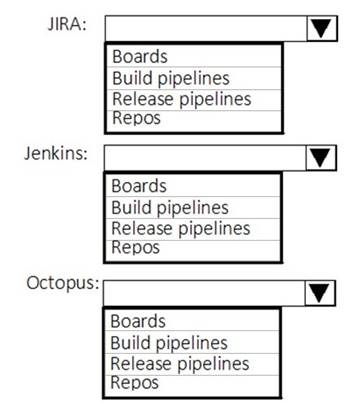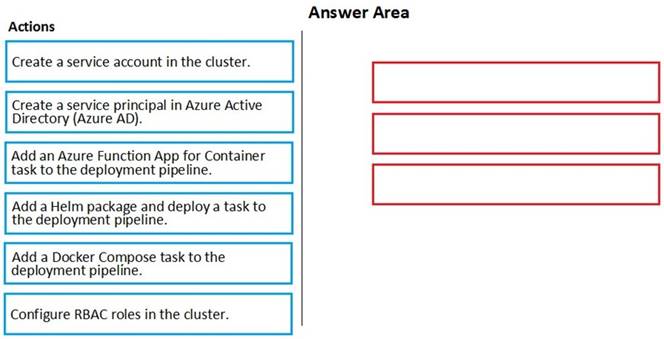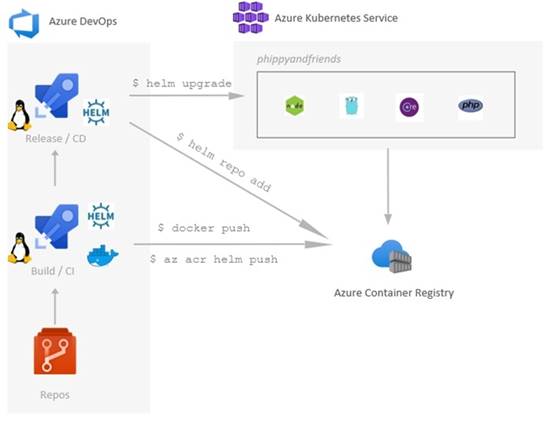DRAG DROP - (Topic 2)
You need to implement the code flow strategy for Project2 in Azure DevOps.
Which three actions should you perform in sequence? To answer, move the appropriate actions from the list of actions to the answer area and arrange in the correct order.
Solution:
Step 1: Create a repository
A Git repository, or repo, is a folder that you've told Git to help you track file changes in. You can have any number of repos on your computer, each stored in their own folder.
Step 2: Create a branch
Branch policies help teams protect their important branches of development. Policies enforce your team's code quality and change management standards.
Step 3: Add a build validation policy
When a build validation policy is enabled, a new build is queued when a new pull request is created or when changes are pushed to an existing pull request targeting this branch. The build policy then evaluates the results of the build to determine whether the pull request can be completed.
Scenario:
Implement a code flow strategy for Project2 that will: Enable Team2 to submit pull requests for Project2.
Enable Team2 to work independently on changes to a copy of Project2.
Ensure that any intermediary changes performed by Team2 on a copy of Project2 will be subject to the same restrictions as the ones defined in the build policy of Project2.
References: https://docs.microsoft.com/en-us/azure/devops/repos/git/manage-your- branches
Does this meet the goal?
Correct Answer:
A
- (Topic 4)
You need to configure GitHub to use Azure Active Directory (Azure AD) for authentication. What should you do first?
Correct Answer:
D
When you connect to a Git repository from your Git client for the first time, the credential manager prompts for credentials. Provide your Microsoft account or Azure AD credentials.
Note: Git Credential Managers simplify authentication with your Azure Repos Git repositories. Credential managers let you use the same credentials that you use for the
Azure DevOps Services web portal. Credential managers support multi-factor authentication through Microsoft account or Azure Active Directory (Azure AD). Besides supporting multi-factor authentication with Azure Repos, credential managers also support two-factor authentication with GitHub repositories.
Reference:
https://docs.microsoft.com/en-us/azure/devops/repos/git/set-up-credential-managers
HOTSPOT - (Topic 4)
You currently use JIRA, Jenkins, and Octopus as part of your DevOps processes. You plan to use Azure DevOps to replace these tools.
Which Azure DevOps service should you use to replace each tool? To answer, select the appropriate options in the answer area.
NOTE: Each correct selection is worth one point.
Solution:
JIRA- BoardJenkins- Build PipelinesOctopus- Release pipelines
Does this meet the goal?
Correct Answer:
A
DRAG DROP - (Topic 4)
You have a protect in Azure DevOps.
You need to associate an automated test to a test case.
Which three actions should you perform in sequence? To answer, move the appropriate actions from the list of actions to the answer area and arrange them in the correct order.
Solution:
The process to associate an automated test with a test case is:
✑ Create a test project containing your automated test. What types of tests are supported?
✑ Check your test project into an Azure DevOps or Team Foundation Server (TFS) repository.
✑ Create a build pipeline for your project, ensuring that it contains the automated test. What are the differences if I am still using a XAML build?
✑ Use Visual Studio Enterprise or Professional 2017 or a later version to associate the automated test with a test case as shown below. The test case must have been added to a test plan that uses the build you just defined.
Does this meet the goal?
Correct Answer:
A
DRAG DROP - (Topic 4)
You have an Azure Kubernetes Service (AKS) cluster.
You need to deploy an application to the cluster by using Azure DevOps.
Which three actions should you perform in sequence? To answer, move the appropriate actions from the list of actions to the answer area and arrange them in the correct order.
Solution:
You can set up a CI/CD pipeline to deploy your apps on a Kubernetes cluster with Azure DevOps by leveraging a Linux agent, Docker, and Helm.
Step 1: Create a service principle in Azure Active Directory (Azure AD)
We need to assign 3 specific service principals with specific Azure Roles that need to interact with our ACR and our AKS.
Create a specific Service Principal for our Azure DevOps pipelines to be able to push and pull images and charts of our ACR.
Create a specific Service Principal for our Azure DevOps pipelines to be able to deploy our application in our AKS.
Step 2: Add a Helm package and deploy a task to the deployment pipeline This is the DevOps workflow with containers:
Step 3: Add a Docker Compose task to the deployment pipeline.
Dockerfile file is a script leveraged by Docker, composed of various commands (instructions) and arguments listed successively to automatically perform actions on a base image in order to create a new Docker image by packaging the app.
Does this meet the goal?
Correct Answer:
A

